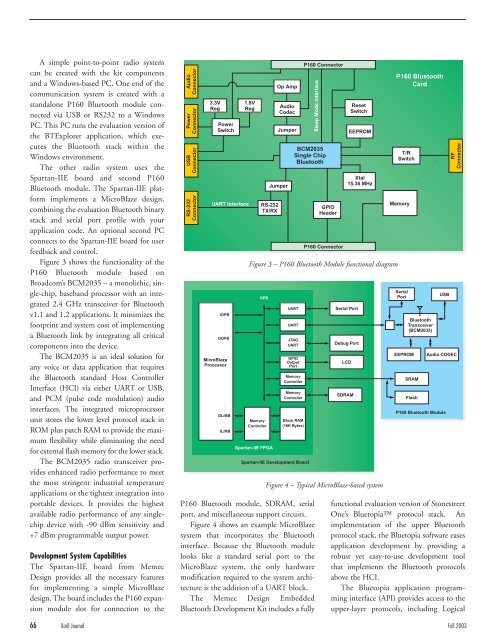Discover New Applications For Low-Cost Solutions Discover ... - Xilinx
Discover New Applications For Low-Cost Solutions Discover ... - Xilinx
Discover New Applications For Low-Cost Solutions Discover ... - Xilinx
Create successful ePaper yourself
Turn your PDF publications into a flip-book with our unique Google optimized e-Paper software.
A simple point-to-point radio system<br />
can be created with the kit components<br />
and a Windows-based PC. One end of the<br />
communication system is created with a<br />
standalone P160 Bluetooth module connected<br />
via USB or RS232 to a Windows<br />
PC. This PC runs the evaluation version of<br />
the BTExplorer application, which executes<br />
the Bluetooth stack within the<br />
Windows environment.<br />
The other radio system uses the<br />
Spartan-IIE board and second P160<br />
Bluetooth module. The Spartan-IIE platform<br />
implements a MicroBlaze design,<br />
combining the evaluation Bluetooth binary<br />
stack and serial port profile with your<br />
application code. An optional second PC<br />
connects to the Spartan-IIE board for user<br />
feedback and control.<br />
Figure 3 shows the functionality of the<br />
P160 Bluetooth module based on<br />
Broadcom’s BCM2035 – a monolithic, single-chip,<br />
baseband processor with an integrated<br />
2.4 GHz transceiver for Bluetooth<br />
v1.1 and 1.2 applications. It minimizes the<br />
footprint and system cost of implementing<br />
a Bluetooth link by integrating all critical<br />
components into the device.<br />
The BCM2035 is an ideal solution for<br />
any voice or data application that requires<br />
the Bluetooth standard Host Controller<br />
Interface (HCI) via either UART or USB,<br />
and PCM (pulse code modulation) audio<br />
interfaces. The integrated microprocessor<br />
unit stores the lower level protocol stack in<br />
ROM plus patch RAM to provide the maximum<br />
flexibility while eliminating the need<br />
for external flash memory for the lower stack.<br />
The BCM2035 radio transceiver provides<br />
enhanced radio performance to meet<br />
the most stringent industrial temperature<br />
applications or the tightest integration into<br />
portable devices. It provides the highest<br />
available radio performance of any singlechip<br />
device with -90 dBm sensitivity and<br />
+7 dBm programmable output power.<br />
Development System Capabilities<br />
The Spartan-IIE board from Memec<br />
Design provides all the necessary features<br />
for implementing a simple MicroBlaze<br />
design. The board includes the P160 expansion<br />
module slot for connection to the<br />
Audio<br />
Connector<br />
Power<br />
Connector<br />
USB<br />
Connector<br />
RS-232<br />
Connector<br />
3.3V<br />
Reg<br />
Power<br />
Switch<br />
UART Interface<br />
IOPB<br />
DOPB<br />
MicroBlaze<br />
Processor<br />
DL/MB<br />
IL/MB<br />
1.8V<br />
Reg<br />
P160 Bluetooth module, SDRAM, serial<br />
port, and miscellaneous support circuits.<br />
Figure 4 shows an example MicroBlaze<br />
system that incorporates the Bluetooth<br />
interface. Because the Bluetooth module<br />
looks like a standard serial port to the<br />
MicroBlaze system, the only hardware<br />
modification required to the system architecture<br />
is the addition of a UART block.<br />
The Memec Design Embedded<br />
Bluetooth Development Kit includes a fully<br />
P160 Connector<br />
P160 Bluetooth<br />
Card<br />
functional evaluation version of Stonestreet<br />
One’s Bluetopia protocol stack. An<br />
implementation of the upper Bluetooth<br />
protocol stack, the Bluetopia software eases<br />
application development by providing a<br />
robust yet easy-to-use development tool<br />
that implements the Bluetooth protocols<br />
above the HCI.<br />
The Bluetopia application programming<br />
interface (API) provides access to the<br />
upper-layer protocols, including Logical<br />
66 Xcell Journal Fall 2003<br />
Op Amp<br />
Audio<br />
Codec<br />
Jumper<br />
Jumper<br />
RS-232<br />
TX/RX<br />
Sleep Mode Interface<br />
BCM2035<br />
Single Chip<br />
Bluetooth<br />
GPIO<br />
Header<br />
P160 Connector<br />
Reset<br />
Switch<br />
EEPROM<br />
Xtal<br />
15.36 MHz<br />
Figure 3 – P160 Bluetooth Module functional diagram<br />
OPB<br />
Memory<br />
Controller<br />
Spartan-IIE FPGA<br />
UART<br />
UART<br />
JTAG<br />
UART<br />
GPIO<br />
Output<br />
Port<br />
Memory<br />
Controller<br />
Memory<br />
Controller<br />
Block RAM<br />
(16K Bytes)<br />
Spartan-IIE Development Board<br />
Serial Port<br />
Debug Port<br />
LCD<br />
SDRAM<br />
Figure 4 – Typical MicroBlaze-based system<br />
T/R<br />
Switch<br />
Memory<br />
Serial<br />
Port<br />
EEPROM<br />
Bluetooth<br />
Transceiver<br />
(BCM2035)<br />
SRAM<br />
Flash<br />
USB<br />
RF<br />
Connector<br />
Audio CODEC<br />
P160 Bluetooth Module

















